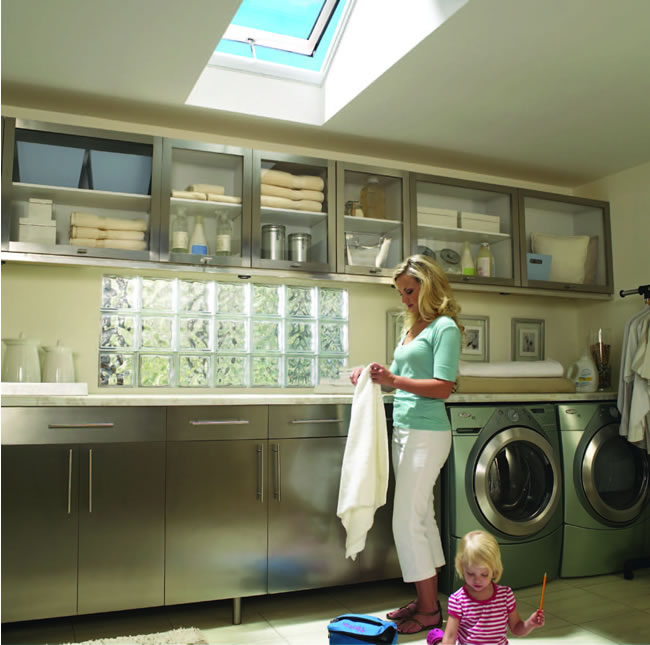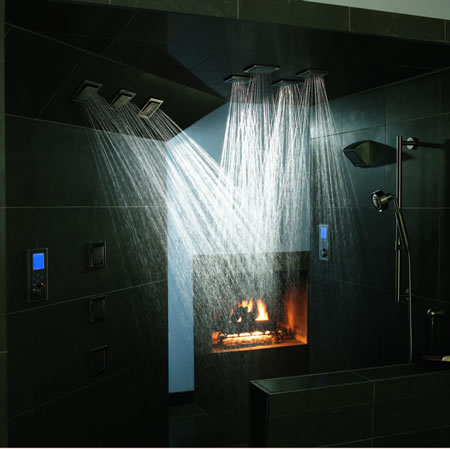by Nita Hull
HOUZZ® + www + HGTV® = ___?___ Housing Consumers
What is the most significant change in housing in the last ten years? In my observation as a space-planner, it is the homeowners themselves! Easy access to inspirational photos + access to live or post-construction experiences and product/material reviews + entire television networks dedicated to housing = SAVVY consumers. The house designer becomes a trusted adviser more than an educator of options. What are well-informed women choosing for their kitchen, laundry room and bathrooms?
KITCHEN TRENDS
OPEN LAYOUT. A by-product of kitchens being open to the entertaining area is the desire to hide messy aspects of food preparation/clean-up and cooking odors. This has spawned a combination walk-in-pantry/closed mini-kitchen located off the primary kitchen, dubbed the “work-in-pantry” by Design Basics LLC, containing a sink, and possibly a refrigerator. Some clients prefer a Wok or Fry kitchen with a sink, range, tiled walls and heavy-duty ventilation, others a kosher kitchen. The interior designer’s role has become significant, as visually, kitchen selections need to blend harmoniously with those in adjoining spaces.
Since the dominant kitchen layout philosophy – the working triangle (the connection between the refrigerator, stove and sink) was based on a single cook in an isolated room it has given way to designing “zones” for storing, food preparation, cooking, clean-up etc. Identifying the triangle is still invaluable as a tool for assessing flow in and through a kitchen plus dual triangles anchored by a second sink facilitates multiple cooks.
Author and kitchen design expert, Ellen Cheever, has noted a fresh take on open kitchen design she calls “The ‘Live-In’ Kitchen Concept” which places the kitchen in the center of the overall living area. She says that this ‘floating’ approach allows various people-related activities to occur along the perimeters of the space; people gathering ‘around’ instead of ‘in’ the kitchen, resulting in “cooking theatre” –others observing and socializing but not getting in the way of the cook. An island is typically the stage for the ‘show’.
ISLAND CENTRAL
The peninsula has given way to an island in medium to large kitchens because it dramatically improves traffic flow. Islands must have a minimum of 42 inches (48-54” is better) between the island and cabinets against the walls, measured between the counter top overhangs. Frequently the primary sink is placed in it, enabling the person working there to see into surrounding rooms and out their windows.
Note: NEVER place the sink right at the end of an island. The primary sink must have counter space on both sides to function properly. I have had clients in tears describing what it is like to NOT have counter on one side and have seen several ugly make-shift attempts to add flip-up counter space out of sheer desperation! Since a huge island can overwhelm a kitchen and the center be difficult to reach for cleaning, two smaller islands are preferred in larger kitchens. CAUTION: If you are forced to walk around an island to get from the sink to the refrigerator, frustration will soon set in – consider adding a second sink.
APPLIANCE CHANGES
In 2013 you are less likely to find a cook top in an island than in 2003 because ventilation for today’s professional style cooking appliances needs the shortest path with a minimum number of turns to move air efficiently. This is accomplished by placing the range on an outside wall if possible. Island hoods making a space feel less open (downdraft ventilation is an alternative) and fears of people sitting too close to sizzling or steaming food are other deterrents.
During the last decade the French door fridge has overtaken the market place, accounting for about 70% of fridge sales for primary kitchens according to Major Appliance Consultant, Brent Campbell at Sears. Pros are the attractive symmetrical look and shorter door swings intruding less into traffic paths. Cons include having to use two hands to open two doors before you can access some of the produce and meat bins, as well as either an open or shut door is always blocking immediate flow from the fridge interior to counter top landing space. Despite their space-saving benefits, combination microwave oven/vent hoods have lost favor because of their height, reduced ventilation capacity, inaccessibility to children and need to reach over hot burners and steaming pots to use it.
CABINETS
MORE DRAWERS.
We are less tolerant now of getting on our hands and knees to fish out items from our base cabinets! The bank of 3 drawers affectionately known as ‘pot drawers’ is being repeated throughout the kitchen. Astute buyers are quick to notice when a builder skimps on drawers and interpret it as a signal that shortcuts are being taken to save money. Full extension drawer hardware is preferred because it allows easy access to the entire contents of the drawer.
FEWER WALL CABINETS.
Reducing the amount of wall cabinets to double the window area or increase a feeling of openness is gaining in appeal as are soft-close hinges –no more door banging! Extending wall cabinets down to the counter top judiciously is in favor, often hiding counter top appliances. An ingenious vertical door lift hinge finally solves the unsatisfactory appliance garage door conundrum!
RECYCLING CENTERS.
Increased recycling is the way of the future. Look for easy to-grab removable containers in pull-out base cabinets because they need to be emptied frequently.
PULL-OUT CABINETS.
Full-height and base-height pull-out cabinets have become enormously popular because they tuck into narrow spaces and items in them are easily accessible.
A separate main floor laundry room shortens your trips to change loads and facilitates hearing the signal buzzers.

Daylight makes any activity more enjoyable. photo courtesy of Velux USA
LAUNDRY PREFERENCES
Having moved away from being the first thing you see when you step into your house from the garage, laundry rooms are being located where the bulk of soiled clothes are generated –close to the bedrooms. If you place the laundry on a second floor, consider it mandatory “insurance” to install a floor drain (not just a drip pan under the washer) for protection against the agony of water damage from a leaking hose or pipe! Since doing laundry can be noisy, buffer it with closets, hallways and bathrooms or soundproof the walls. A separate main floor laundry room shortens your trips to change loads and facilitates hearing the signal buzzers.
Adding a wet or dry clothes hanging rod is in demand as are fold-down ironing boards. A base pull-out cabinet beside the laundry team allows for comfortable access to detergent, etc. rather than reaching high up into a wall cabinet over the machines. Provide natural light wherever possible. Measure carefully if you want to place a folding counter above a pair of front-loading machines because it frequently turns out to be uncomfortably high. Time has shown that a front-load washer door must be left ajar for a few hours after use to dry out the rubber gasket and prevent smelly mold growth. Since the open door can be problematic if your laundry machines are placed inside a closet, consider an internal or external sliding door if wall space permits.

Art and high tech are equally represented in this fabulous shower. photo courtesy of Kohler
BATHROOM VOGUE

Art and high tech are equally represented in this fabulous shower. photo courtesy of Kohler
Freestanding soaker tubs, often sculptural in design are taking center stage in owner’s en suite bathrooms. Be sure to sit in the tub in the showroom before you buy –not all beautiful designs are comfortable. Climbing in and out of a taller tub is harder and grab bars more challenging to install when the tub is not close to walls. Corner tub placement is waning because it requires more floor space and the rear corner area is awkward to reach for cleaning.
Large showers with multiple jets, a rain shower head (in combination with a wall-mounted removable hand held shower), niche for bottles, and a built-in bench continue to dominate en suite design. A trend across the aging baby boomer market is a curbless shower paired with a linear drain. Doorless showers are popular and can reduce cleaning chores but a significant number of users complain about chilly drafts even if they have heated floors and a heat lamp at the exit. Vanities that appear to be independent furniture pieces rather than built-in cabinets are very popular but they need a minimum of 3 inches clearance from the wall on each side or cleaning, painting and wallpapering in the narrow cavity is difficult. Wall hung ‘floating’ vanities frequently paired with vessel sinks predominate modern style rooms. Many vessel sink designs are best suited for low traffic powder rooms because of the splash factor.
TIP. Wood lovers take note – tiles that truly look remarkably like wood are now available.
Five Developments in Major Appliances
According to Brent Campbell, Major Appliance Consultant with Sears
1. Direct drive clothes washers are replacing belt driven models because they drastically reduce vibration during the spin cycle –invaluable when laundry is located on a wood framed floor.
2. Front-loading washers are increasing in capacity from 4 cubic feet to 6 and dryers from 7 cubic feet to 9, resulting in fewer loads which save time and energy.
3. A few years ago LG introduced an impressive low-profile freestanding range that looks like a slide-in but without the expensive disadvantages – now other manufacturers are following suit.
4. The demand for counter depth refrigerators has enabled them to come DOWN in price and UP in selection.
5. Dishwasher tubs are taller (allowing for bulkier items) and sound insulation continues to improve –much appreciated in today’s open kitchens. I just had to ask Brent the big stainless steel question –has it run its course? Is it on the way out? He swept his hand around the showroom asking me what I saw. I saw a handful of white appliances in the far back corner –everything else was stainless steel.
Case closed. No matter that it is challenging to keep clean –the beauty still outweighs the extra maintenance for the majority of people. Where your budget allows, cabinet door panel-ready dishwashers and refrigerators are an attractive alternative.
